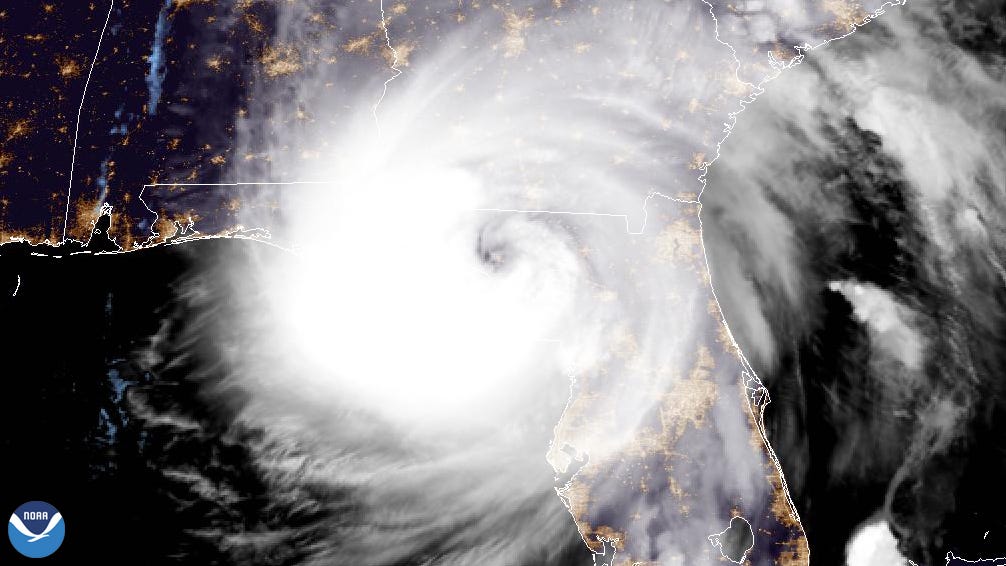Hurricane Helene and the Risks Posed to Chemical Facilities

On Friday Sept 27th, Hurricane Helene made its way inland leaving a trail of destruction through 6 states and leaving millions without electricity. Included amongst the homes and schools without power are facilities responsible for storing and manufacturing highly volatile chemicals known to pose significant risks to human health.
76 RMP Facilities in Counties Without Power
On Friday morning, roughly 77 counties were reported to be almost 100% without power, according to PowerOutage.us. Within those counties, I identified 76 facilities known to have chemicals that have the potential to become volatile if not stored properly. Meaning, these facilities are extremely vulnerable to power loss, structural damage to their storage systems, and failure of essential refrigeration. Damage to these facilities can be truly catastrophic.
What might this look like?
The Arkema fire is the best example of what can happen if a facility is not prepared for extreme weather. During Hurricane Harvey in 2017, extreme amounts of rain flooded the Houston area, including the surrounding town of Crosby, Texas. The Arkema facility was overcome by several feet of flooding. Backup generation failed, and the volatile chemicals stored at the plant exploded. The resulting chemical release required the evacuation of 200 people within 1.5 miles of the facility, and 21 people sought medical attention as a result of the event.
More recently, in 2020, a release of chlorine gas occurred at a BioLab facility after another Category 4 storm – Hurricane Laura. Extreme winds produced by Laura damaged the facility outside of Lake Charles, LA, causing rainwater to enter the building and find its way into a store of trichloroisocyanuric acid (TCCA) – a chemical that’s highly reactive when exposed to small amounts of water. The chemical began to degrade, generating heat and eventually lead to a fire and the release of chlorine gas into the surrounding community and environment.
Unfortunately, the same company – BioLab – experienced a significant fire and release of chlorine gas outside of Atlanta, GA on Monday. Although the reported cause is unrelated to the storm, the coincidence of extreme weather prevented a speedy response by emergency responders.
So far, it seems like most facilities in the path of Helene have weathered the storm. News of serious incidents haven’t found their way into my inbox or to the front page of any major news outlets. However, that does not mean that smaller events have not occurred, nor does it mean we are in the clear. Some energy companies are saying they won’t be able to get power back to their service areas until Friday.
I want to emphasize that just because something hasn’t made it into the headlines doesn’t mean there aren’t facilities that have experienced accidental releases. RMP incidents don’t always include a big explosion. It is also important to remember that there are people living near these facilities who are in danger of potential exposure regardless of the weather. Often, it is underserved communities who live near these facilities and bear the brunt of harm when these facilities explode or leak chemicals. These communities live with the stress and anxiety of potential disasters every day. Their health and well-being are heavily impacted by the success with which these facilities are regulated on a daily basis.
How often do these things happen, really?
More often than you might think. And it’s not particularly unusual to hear about fires or other incidents occurring because of fire, floods, or other natural disasters. These natural hazard triggered technological events are known as “natech” events, and they are a significant public health threat.
The Coalition to Prevent Chemical Disaster maintains a database of incidents that occur throughout the US. The database lists 26 weather related incidents since 2021– 4 of which have occurred this year – and many more occurring as a result of non-weather related issues.
The thing is, with climate change, the frequency and severity of storms is increasing and, up until recently facilities weren’t required to consider extreme weather and climate change when developing their risk management plans.
So, what is being done?
Many of these facilities are regulated under a section of the EPA’s Clean Air Act known as the Risk Management Program (RMP). The rule requires facilities to have systems, structures, and protocols in place to protect the health of the facility staff, first responders, the surrounding community, and the environment. Documentation of these protocols must be submitted to the EPA every five years; however, the question remains if the current requirements are sufficient.
The RMP rule was recently updated with a number of improvements, including requiring facilities to perform analysis to identify the risk posed by climate change and extreme weather; however, many advocates feel the rule continues to fall short.
We are continuing to learn more every day about the extent of damage caused by Hurricane Helene – one of the deadliest and costliest storms in U.S. history. But one thing we should have learned by now is that there is no such thing as being over-prepared when it comes to the safety of industrial facilities, whether they be on the coast or farther inland. We know that there are thousands of facilities across the country at risk and we should be doing everything we can to mitigate that risk.
About the Author
Casey Kalman is a public health and GIS professional with a special interest in environmental health. She uses her knowledge of environmental health and policy along with her expertise in mapping to identify and analyze potential health threats posed to the public during extreme weather events.
That’s it for today - Thank you so much for reading SciLight!
If you enjoyed today’s post, please like it or share it with others. You can also support the work we do to shine a light on the politicization of science by becoming a paid subscriber!
If you want to share today’s post as a web page with your network, click this button:
If you have suggestions, questions, comments, or want to drop us a line - send it all to scilightsubstack@gmail.com





